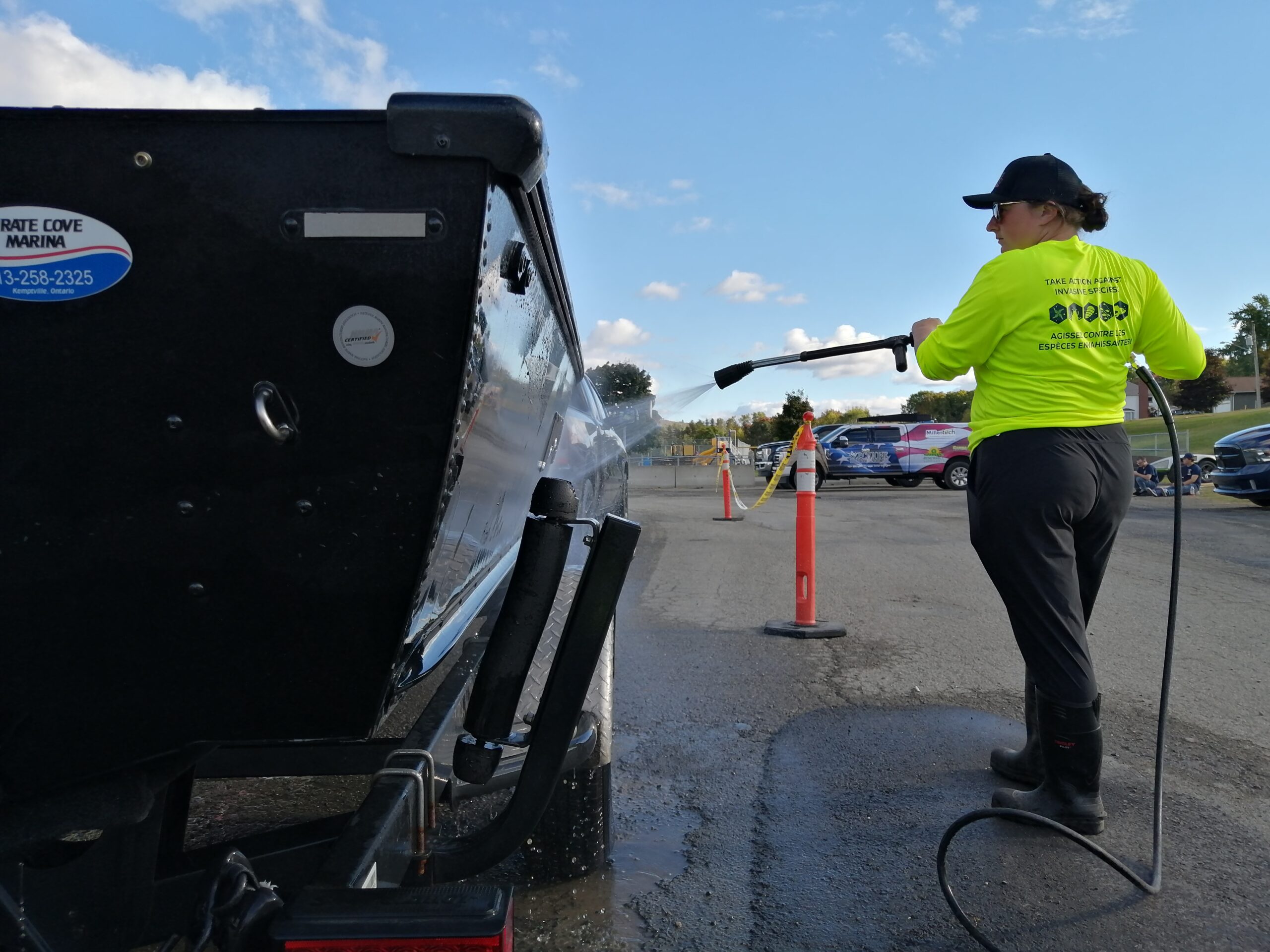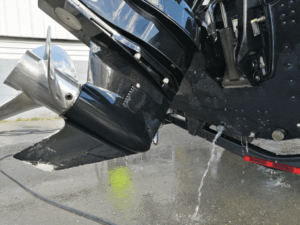Preventing the Spread – One Boat at a Time!
 Sarah Cusack, Project Coordinator with the New Brunswick Invasive Species Council, using their Mobile Decontamination Unit to clean a boat at local tournament.
Sarah Cusack, Project Coordinator with the New Brunswick Invasive Species Council, using their Mobile Decontamination Unit to clean a boat at local tournament.
Invasive Species Councils Take Action to Protect Our Waterways with the Clean, Drain, Dry Program
With another busy fishing and boating season ending, boats and docks leave the water as winter approaches. Because of the efforts of our East Coast chapters, many of these boats are spotless and free of invasive species.
This past summer, two of the Canadian Council on Invasive Species’ chapters, the New Brunswick Invasive Species Council (NBISC) and Nova Scotia Invasive Species Council (NSISC), have been hard at work preventing the spread of aquatic invasive species through a proactive approach that is new to the provinces. As part of a broader outreach and education strategy, both chapters have received their own mobile decontamination stations, which have become a key tool in protecting our lakes and rivers from aquatic invasive species threatening biodiversity and water quality.
Clean, Drain, Dry: Protecting Our Waterways
At the heart of this initiative is the Clean, Drain, Dry program, a proven and effective strategy for reducing the spread of aquatic invasive species between bodies of water. Species like zebra mussels and invasive aquatic plants like Eurasian watermilfoil can quickly overtake native populations, disrupting ecosystems and clogging the waterways we use. Once established, invasive species are notoriously difficult to manage or remove, which is why prevention is key.
Boaters, anglers, and water enthusiasts are encouraged to follow three simple steps after leaving the water:
- Clean your boat, trailer, and equipment of any visible plants, animals, or mud.
- Drain all water from your boat and gear, including live wells and bait containers.
- Dry your boat thoroughly before launching it in a new location.
Positioned at popular boat launches, borders, and fishing tournaments across the East Coast, mobile boat decontamination stations help make these practices more accessible and convenient for local communities. By ensuring boats are clean, drained, and dry, we can prevent harmful invaders from hitchhiking to new areas where they can wreak havoc on ecosystems.
 Mobile Decontamination Unit stationed at a popular boat launch in New Brunswick.
Mobile Decontamination Unit stationed at a popular boat launch in New Brunswick.
New Brunswick Invasive Species Council (NBISC)
The New Brunswick Invasive Species Council (NBISC) has engaged with hundreds of boaters and anglers throughout the summer while set up at local fishing tournaments, outreach events and popular boat launches. Their chief concern, is the invasive zebra mussel, which was first reported in New Brunswick just last year.
“As the season progressed, we saw more and more boaters engaging with us to have their boats cleaned. We are excited to hit the ground running next season and keep the momentum going.”
Says Sarah Cusack, Project Coordinator with NBISC who has been leading their aquatic invasive species projects this past summer.
The response to the boat decontamination stations has been overwhelmingly positive, with many boaters eager to take advantage of this free service and passionate about protecting the waterways they recreate on. The highlight of their summer was participating in the Pan-American Black Bass Championship in Nackawic, NB. This 4-day international tournament saw dozens of boats from 11 countries using the Wolastoq (St. John River). Although large tournaments like these pose higher risks of moving aquatic invasive species, NBISC and their partners at the Department of Fisheries and Oceans Canada and New Brunswick Department of Natural Resources, were able to decontaminate majority of these boats
Nova Scotia Invasive Species Council (NSISC)
While the New Brunswick Invasive Species Council (NBISC) continues its work to prevent the spread of zebra mussels within the province, the Nova Scotia Invasive Species Council (NSISC) has been striving to prevent the invasive mussel from entering Nova Scotia waters. This summer, NSISC’s primary focus was on supporting decontamination and monitoring at areas of high risk like popular fishing lakes. NSISC also partnered with Stantec, using their decontamination station on several pieces of field equipment at Little Albro Lake, where invasive yellow floating heart is actively managed.
Sherri MacNeil, NSISC’s Aquatic Invasive Species Project Coordinator, expressed how grateful they are for the support they received this past summer.
“Managing invasive species at busy events takes an ‘all hands on deck’ approach. There are so many logistics to mobilizing these units, and operating them at a derby where there are in excess of 25 to 30 watercraft, trailers, trucks and often limited space. The whole process can be a challenge without support from partners and communities.”
NSISC’s efforts to prevent zebra mussels from being introduced into the province extended to a monitoring project, where they conducted environmental DNA swabbing on watercraft coming from within and outside of Nova Scotia at a fishing derby. Collected samples were sent to the Department of Fisheries and Oceans for analysis of zebra mussel DNA. Nova Scotians have to stay vigilant, but NSISC staff are confident that their efforts monitoring, decontaminating and educating have made a difference in keeping Nova Scotian waters zebra mussel-free.
Looking Ahead

As chapters continue their outreach in coming years, they are building towards a culture of stewardship among the boating community on the East Coast. Their ultimate goal is for the practice of Clean, Drain, Dry to come as second nature to boaters, and for boat decontamination stations to be readily accessible at popular boat launches and at provincial borders. Despite the work ahead, chapters are laying down the groundwork towards a more resilient, healthy future for waters in New Brunswick and Nova Scotia.
Learn more about Clean, Drain, Dry and take the pledge »